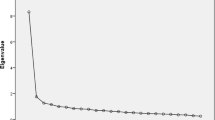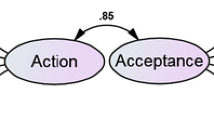Abstract
Patients with social phobia frequently report fearing that their symptoms of anxiety will adversely affect the comfort and performance of others, but these fears are not typically included in traditional measures. In Study 1, an initial 26-item pool was developed to assess this fear dimension and then administered in conjunction with measures of social phobia, anxiety and depression, to undergraduate students (n = 277), patients with social phobia (n = 101) and patients with panic disorder (n = 25). A unidimensional scale, the Social Anxiety—Discomfort to Others Scale (SA-DOS), was derived based on exploratory factor analyses and item-response theory. The unitary structure of the SA-DOS was replicated in a second sample of patients with social phobia (n = 100). In Study 2, participants with social phobia were found to have significantly higher SA-DOS scores than patients with panic disorder and student controls. Further, the SA-DOS was found to possess convergent and divergent validity in relation to validated measures assessing fear of negative evaluation and psychopathological constructs from the cross-cultural literature. In Study 3, baseline SA-DOS scores were found to be associated with poorer treatment response in a sample of patients with social phobia (n = 55) receiving Cognitive-Behavioral Group Therapy. These preliminary findings suggest that fear of causing discomfort to others is a related but distinct fear dimension of social phobia requiring greater attention in the conceptualization and treatment of the disorder.
Similar content being viewed by others
References
Alden, L. E. (2001). Interpersonal perspectives on social phobia. In W. R. Crozier, & L. E. Alden (Eds.), International handbook of social anxiety: Concepts, research and interventions relating to the self and shyness (pp. 381–404). New York: John Wiley & Sons.
Alden, L. E., & Safran, J. (1978). Irrational beliefs and nonassertive behaviour. Cognitive Therapy and Research, 2, 357–364.
American Psychiatric Association. (2000). Diagnostic and statistical manual of mental disorders (4th ed., text revision). Washington, DC: Author.
Antony, M. M., Orsillo, S. M., & Roemer, L. (2001). Practitioner’s guide to empirically-based measures of anxiety. New York: Kluwer Academic/Plenum.
Baker, S. L., Hienrichs, N., Kim, H-J., & Hofmann, S. (2002). The Liebowitz social anxiety scales as a self-report instrument: A preliminary psychometric analysis. Behaviour Research and Therapy, 40, 701–715.
Beck, A. T., Epstein, N., Brown, G., & Steer, R. A. (1988). An inventory for measuring clinical anxiety: Psychometric properties. Journal of Consulting and Clinical Psychology, 56, 893–897.
Beck, A. T., & Steer, R. A. (1987). Manual for the revised Beck Depression Inventory. San Antonio, TX: Psychological Corporation.
Beck, A. T., & Steer, R. A. (1993). Beck Anxiety Inventory: Manual. San Antonio, TX: Psychological Corporation.
Beck, A. T., Steer, R. A., & Garbin, M. G. (1988). Psychometric properties of the Beck Depression Inventory: Twenty-five years of evaluation. Clinical Psychology Review, 42, 861–865.
Clark, D. M., & Wells, A. (1995). A cognitive model of social phobia. In R. G. Heimberg, M. R. Liebowitz, D. A. Hope, & F. R. Schneier (Eds.), Social phobia: Diagnosis, assessment, and treatment. New York: Guilford.
Embretson, S. E., & Reise, S. P. (Eds.) (2000). Item response theory for psychologists. Mahwah, NJ: Lawrence Erlbaum.
First, M. B., Gibbon, M., Spitzer, R. L., & Williams, J. B. W. (1996). User’s guide for the structured clinical interview for DSM-IV Axis I Disorders—Research Version (SCID-I, Version 2.0, February 1996 Final Version). New York: Biometrics Research.
Fresco, D. M., Coles, M. E., Heimberg, R. G., Liebowitz, M. R., Hami, S., Stein, M. B., & Goetz, D. (2001). The Liebowitz Social Anxiety Scale: A comparison of the psychometic properties of self-report and clinician-administrated formats. Psychological Medicine, 31, 1025–1035.
Glass, C. R., & Furlong, M. (1990). Cognitive assessment of social anxiety: Affective and behavioural correlates. Cognitive Therapy and Research, 14, 365–384.
Hartman, L. M. (1983). A meta-cognitive model of social anxiety: Implications for treatment. Clinical Psychology Review, 3, 435–456.
Heimberg, R. G. (2002). Cognitive-behavioural therapy for social anxiety disorder: Current status and future directions. Biological Psychiatry, 51, 101–108.
Heimberg, R. G., & Becker, R. E. (2002). Cognitive-behavioural group therapy for social phobia: Basic mechanisms and clinical strategies. New York: Guilford.
Heimberg, R. G., Liebowitz, M. R., Hope, D. A., Schneier, F. R., Holt, C. S., Welkowitz, L. A., Juster, H. R., Campeas, R., Bruch, M. A., Cloitre, M, Fallon, B., & Klein, D. F. (1998). Cognitive behavioural group therapy vs. phenelzine therapy for social phobia: 12-week outcome. Archives of General Psychiatry, 55, 1133–1141.
Heimberg, R. G., Rapee, R. M, & Turk, C. L. (2002). A cognitive-behavioural formulation of social phobia. In R. G. Heimberg, & R. E. Becker (Eds.), Cognitive-behavioural group therapy for social phobia. New York: The Guilford Press.
Hope, D. A., & Heimberg, R. G. (1993). Social phobia and social anxiety. In D. H. Barlow (ed.), Clinical handbook of psychological disorders: A step-by-step treatment manual (2nd ed., pp. 99–106). New York: Guilford.
Ingram, R. E, Miranda J., & Segal, Z. V. (1998). Cognitive vulnerability to depression. New York: The Guilford Press.
Iwamasa, G. Y. (1997). Asian Amercians. In S. Fredman (Eds.), Cultural issues in the treatment of anxiety (pp. 99–129). New York: The Guilford Press.
Iwase, M., Nakao, K., Takaishi, J., Yorifuji, K., Ikezawa, K., & Takeda, M. (2000). An empirical classification of social anxiety: Performance, interpersonal and offensive. Psychiatry and Clinical Neurosciences, 54, 67–75.
Kleinknecht, R. A., Dinnel, D. L., Kleinknecht, E. E., Hiruma, N., & Harada, N. (1997). Cultural factors in social anxiety: A comparison of social phobia symptoms and taijin kyofusho. Journal of Anxiety Disorders, 11, 157–177.
Liebowitz, M. R. (1987). Social Phobia. Modern Problems in Pharmacopsychiatry, 22, 141–173.
Linacre, J. M. (2003). Ministep: Student/evaluation version of Winsteps (Version 3.38) [Computer software and manual]. Retrieved from http://www.winsteps.com.
Mattick, R. P., & Clarke, L. C. (1998). Development and validation of measures of social phobia scrutiny, fear, and social interaction anxiety. Behaviour Research and Therapy, 36, 455–470.
Meng, X-L, Rosenthal, R., & Rubin, D. B. (1992). Comparing correlated correlation coefficients. Psychological Bulletin, 111, 172–175.
Oakman, J, Van Ameringen, M., Mancini, D., & Farvolden, P. (2003). A confirmatory factor analysis of a self-report version of the Liebowitz social anxiety scale. Journal of Clinical Psychology, 59, 149–161.
Ono, Y., Yoshimura, K., Yamauchi, K., Asai, M., Young, J., Fuguhara, S., & Kitumura, T. (2001). Taijin kyofusho in a Japanese community population. Transcultural psychiatry, 38, 506–514.
Osman, A., Gutierrez, P. M., Barrios, F. X., Kopper, B. A., & Chiros, C. E. (1998). The Social Phobia and Social Interaction Anxiety Scales: Evaluation of psychometric properties. Journal of Psychopathology and Behavioural Assessment, 20, 249–264.
Prince, R., & Tcheng-Laroche, F. (1987). Culture-bound syndromes and international disease classifications. Culture, Medicine, and Psychiatry, 11, 3–19.
Rapee, R. M., & Heimberg, R. G. (1997). A cognitive-behavioural model of anxiety in social phobia. Behaviour Research and Therapy, 35, 741–756.
Rasch, G. (1960). Probabilistic models for some intelligence and attainment tests. Chicago: The University of Chicago Press.
Rector, N. A., & Bagby, R. M. Saturation levels of the Big Five Domains and Facets in depressive and anxiety disorders. Manuscript in preparation.
Rector, N. A., Kocovski, N. L., & Ryder, A. Social anxiety and the fear of causing discomfort to other: Conceptualization and treatment. Journal of Clinical and Social Psychology (in press).
Stopa, L., & Clark, D. M. (1993). Cognitive processes in social phobia. Behaviour Research and Therapy, 31, 255–267.
Stopa, L., & Clark, D. M. (2000) Social phobia and interpretation of negative events. Behaviour Research and Therapy, 38, 273–283.
Suzuki, K., Takei, N., Kawai, M., Minabe, Y., & Mori, N. (2003). Is taijin kyofusho a culture-bound syndrome? American Journal of Psychiatry, 160, 1358.
Takahashi, T. (1972). Anthropophobiacs in a social club: A theoretical report on the abnormal sociability of the anthropophobiacs. Journal of Mental Health, 46, 181–192.
Takahashi, T. (1989). Social phobia syndrome in Japan. Comprehensive Psychiatry, 30, 259–269.
Turner, S. M., Beidel, D. C., & Townsley, R. M. (1992). Social phobia: A comparison of specific and generalized subtype and avoidant personality disorder. Journal of Abnormal Psychology, 101, 326–331.
van der Linden, W. J., & Hambleton, R. K. (Eds.) (1997). Handbook of modern item response theory. New York: Springer.
Wallace, S. T., & Alden, L. E. (1997). Social phobia and positive social events: The price of success. Journal of Abnormal Psychology, 106, 416–424.
Watson, D., & Friend, R. (1969). Measurement of social-evaluative anxiety. Journal of Consulting and Clinical Psychology, 33, 448–457.
Weeks, J. W., & Heimberg R. G. (2004). The fear of positive evaluation scale (FPES): Scale development and psychometric analysis of a novel social anxiety measure. Paper presented at the meeting of the Association for Advancement of Behavior Therapy, New Orleans.
Wells, A. (1997). Cognitive therapy of anxiety disorders: A practice manual and conceptual guide. Chichester, UK: John Wiley & Sons.
Acknowledgment
During the preparation of this paper, the first author was supported by research grants from the Canadian Institutes of Health Research and the Ontario Mental Health Foundation, the second author was supported by a Social Sciences and Humanities Research Council of Canada (SSHRC) postdoctoral fellowship. We would like to acknowledge the very helpful feedback from Dr. Karen Rowa on an earlier draft of this manuscript and Kate Szacun-Shimizu for her editorial assistance.
Author information
Authors and Affiliations
Corresponding author
Rights and permissions
About this article
Cite this article
Rector, N.A., Kocovski, N.L. & Ryder, A.G. Social Anxiety and the Fear of Causing Discomfort to Others. Cogn Ther Res 30, 279–296 (2006). https://doi.org/10.1007/s10608-006-9050-9
Published:
Issue Date:
DOI: https://doi.org/10.1007/s10608-006-9050-9




